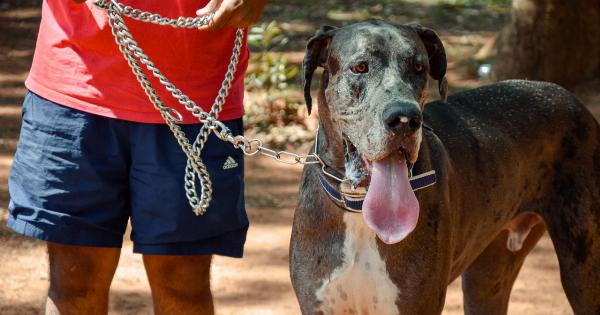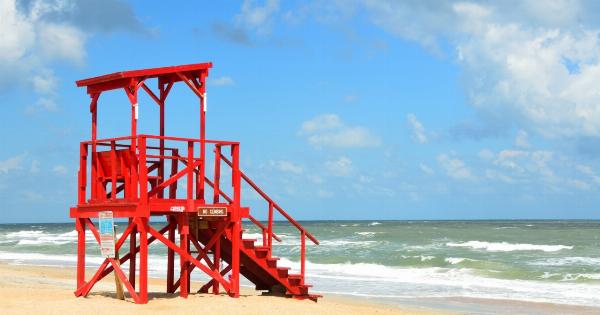The beach is a popular destination for many dog owners looking to enjoy the sun, sand, and surf with their furry friends. While it can be a great place to have fun and relax, there are also several risks and dangers that pet owners need to be aware of.
One of the most important things to remember is to never leave your dog unsupervised at the beach. In this article, we will explore some of the potential hazards and explain why it is crucial to keep a watchful eye on your pup at all times.
The Dangers of the Beach
Beaches can seem like a paradise for dogs, but there are several hazards that can put them at risk. Let’s take a closer look at some of the dangers that pet owners should be aware of:.
Rip Currents
Rip currents are powerful, fast-moving channels of water that flow away from the shore. They can be extremely dangerous for both humans and animals.
Dogs can easily be swept away by the force of the current, making it difficult for them to swim back to safety. This is why it is important to keep a close eye on your dog at all times and avoid areas with strong currents.
Dehydration and Heat Stroke
Dogs are at risk of dehydration and heat stroke at the beach, especially on hot summer days. They can quickly become overheated, as they are unable to regulate their body temperature as effectively as humans.
Signs of heat stroke include excessive panting, weakness, vomiting, and collapse. Always provide your dog with plenty of fresh water and a shady spot to rest.
Hot Sand and Sunburn
The sand on the beach can become scorching hot under the summer sun. This can burn your dog’s paw pads, causing pain and discomfort. Additionally, just like humans, dogs can also suffer from sunburn.
The areas most at risk include the nose, ears, belly, and any areas with thin or light-colored fur. Consider using a doggy sunscreen, and make sure your pup has a cool place to relax away from the hot sand.
Beach Pollution
Unfortunately, not all beaches are kept clean and free from pollution. Trash, broken glass, and other hazardous materials can be harmful to your dog if they come into contact with them.
It is essential to carefully inspect the area before letting your pup roam freely. Additionally, some beaches may contain harmful bacteria or toxins in the water or along the shoreline. Keep an eye out for any signs or warnings posted by local authorities.
Wildlife and Marine Life
Encounters with wildlife and marine life can be fascinating but also dangerous for your dog. Depending on the beach location, there may be wild animals, such as snakes or coyotes, that pose a threat to your pup.
Additionally, some marine life, like jellyfish or blue-ringed octopuses, can deliver painful stings or bites. Keep your dog on a leash and avoid areas that may be home to dangerous animals.
Poisonous Plants and Fruits
Many beaches have plants and fruits that could be poisonous to dogs. Some common examples include poison ivy, oak, or sumac, as well as plants with thorns or sharp edges that can cause injuries.
Educate yourself on the local flora and make sure your dog doesn’t eat anything they shouldn’t.
Sharp Objects
Broken glass, sharp shells, and fishing hooks are just a few examples of sharp objects that can be found on the beach. These can cause serious injuries, such as cuts, punctures, or even infections if they penetrate your dog’s skin.
Always keep a close eye on your surroundings to ensure your dog doesn’t step on or ingest anything hazardous.
Unfriendly Dogs and People
Not all dogs or people at the beach may be as friendly as your furry friend. Unsupervised encounters with aggressive dogs or inconsiderate people can quickly escalate into dangerous situations.
Always keep your dog on a leash and be cautious of your surroundings. If you notice any signs of aggression or discomfort in your dog, be prepared to remove them from the situation.
Overexertion
Dogs can easily become overexerted at the beach, especially if they are swimming, running, or playing fetch for extended periods of time. Lack of rest and continuous physical activity can lead to exhaustion, dehydration, or injuries.
Remember to provide your dog with frequent breaks and encourage them to rest in a cool and shaded area.
Lost or Stolen Pets
The beach can be a crowded place, and dogs can easily get lost or even stolen if they are left unsupervised. A frightened or disoriented dog may quickly wander off or be taken by someone who mistakes them for a stray.
Always make sure your dog has their collar with up-to-date identification tags and is properly microchipped.
Enjoy the Beach Safely with Your Dog
While there are potential dangers at the beach, with proper precautions and supervision, you can still enjoy a fun-filled day with your dog. Remember to:.
- Keep an eye on your dog at all times.
- Avoid areas with rip currents or strong currents.
- Provide plenty of fresh water and shade.
- Protect your dog’s paws from hot sand.
- Consider using doggy sunscreen.
- Inspect the beach for any hazards or pollution.
- Keep your dog away from wildlife or marine life.
- Avoid plants or fruits that could be toxic.
- Watch out for sharp objects.
- Be cautious of unfriendly dogs or people.
- Prevent overexertion and provide frequent breaks.
- Ensure your dog has proper identification.
By following these guidelines, you can help keep your dog safe while still enjoying the beautiful beach environment. Spending quality time together while ensuring your dog’s well-being should be the focus of any trip to the beach.





























